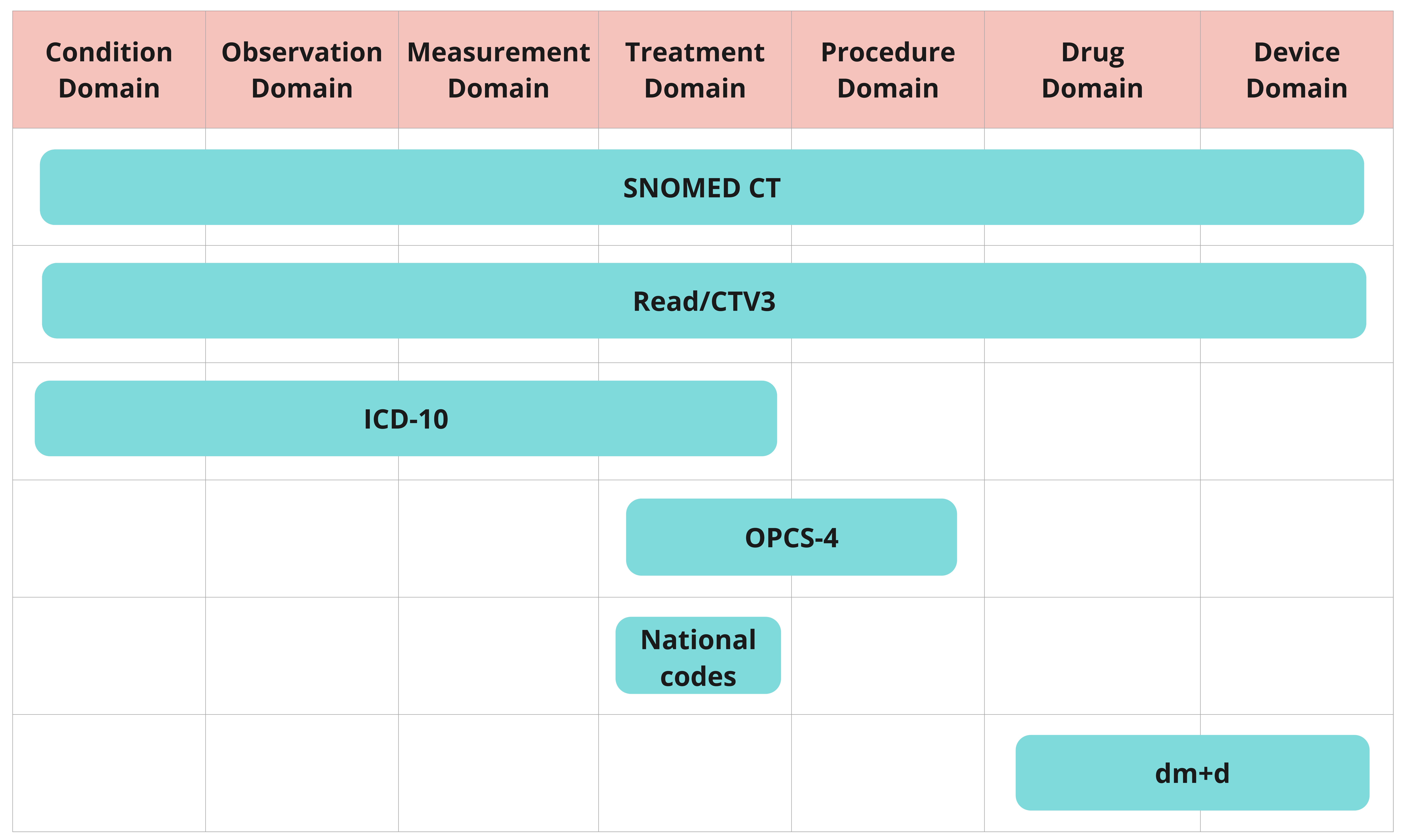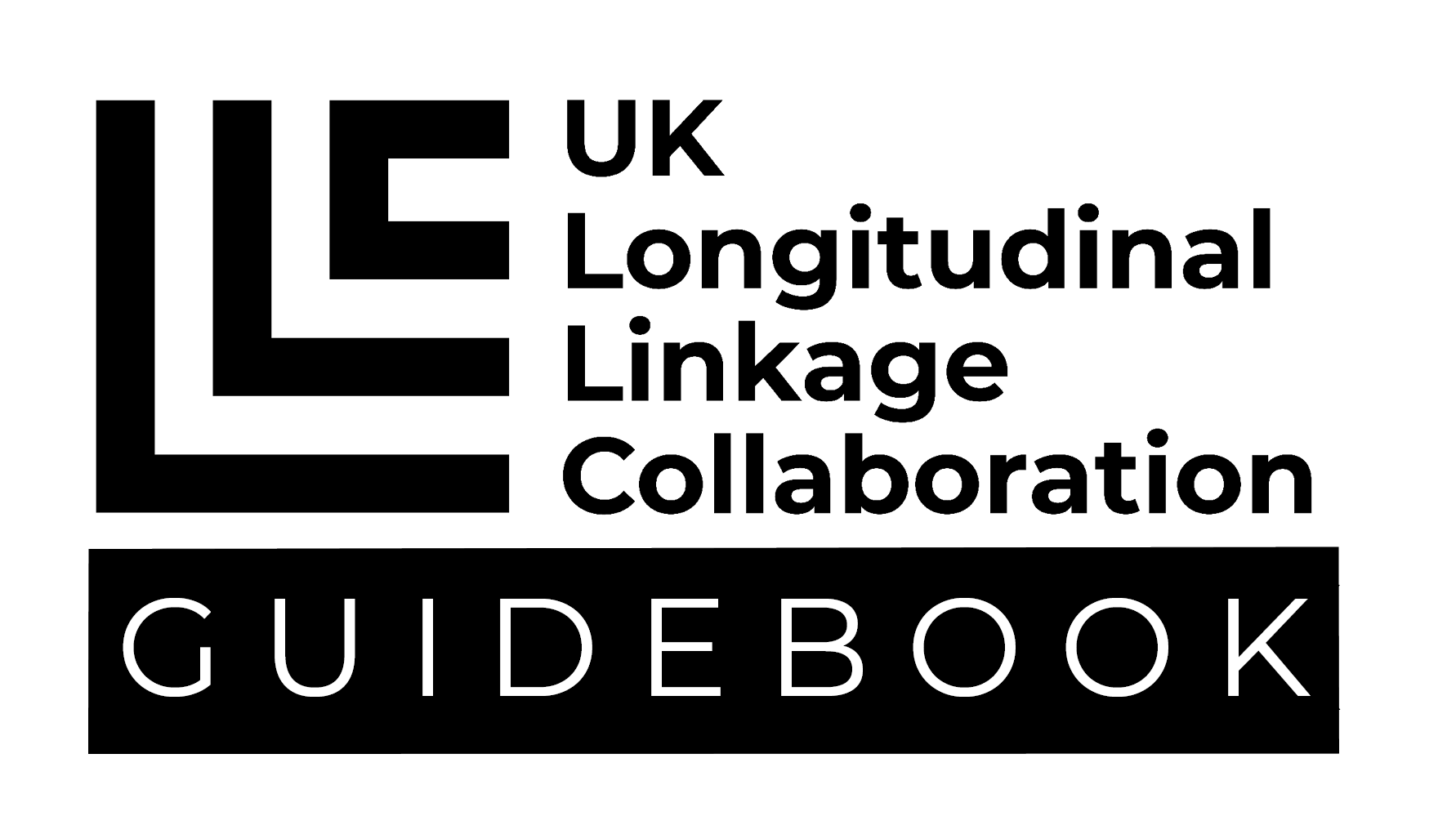Coded variables in NHS England datasets#
Last modified: 12 Dec 2025
Codes are used for a range of statistical, clinical and management purposes, e.g. by Integrated Care Boards (ICBs) to reimburse hospitals for the care they have provided.
The main clinical classifications mandated by NHS England are SNOMED CT, ICD-10 and OPCS-4. However, you’ll also find Read codes, NHS national codes, dm+d codes and non-clinical classifications in the datasets. The clinical domains covered by these different systems vary, as shown in Figure 1 below.
In hospital settings, specialist clinical coders translate medical information in patients’ case notes into codes post-discharge. In other settings, clinicians directly record information in the electronic patient record (EPR) at the point of care.

Figure 1 Scopes of the clinical classification systems used in NHS England datasets Note: Figure 1 is adapted from the Bennett Institute for Applied Data Science’s blog: An Introduction to Clinical Codes and Terminology
Classification systems#
Table 1 lists the systems used in each NHS England dataset in the UK LLC TRE. Below the table we summarise the key aspects of each system.
For the datasets marked with an asterisk (*) and in italics, you must submit a clinical code list alongside your data request when you apply to access data in the UK LLC TRE.
Note: The information in the table was originally obtained from the NHS England API, apart from DEMOGRAPHICS and MORTALITY - for these two datasets information was obtained from the NHS England Metadata dashboard We are aware that the information from the API is not comprehensive and we are working to update this table.
Table 1 Classification systems used in NHS England datasets
Dataset name in TRE |
SNOMED-CT |
ICD-10 |
ICD-9 |
OPCS-4 |
Read |
dm+d |
BNF |
National codes |
Other |
|---|---|---|---|---|---|---|---|---|---|
*HESOP |
✗ |
✓ |
✗ |
✓ |
✗ |
✗ |
✗ |
✓ |
✓ |
*HESAPC |
✗ |
✓ |
✗ |
✓ |
✗ |
✗ |
✗ |
✓ |
✓ |
*HESAE |
✗ |
✗ |
✗ |
✗ |
✗ |
✗ |
✗ |
✓ |
✗ |
ECDS |
✓ |
✗ |
✗ |
✗ |
✗ |
✗ |
✗ |
✓ |
✓ |
MHSDS |
✓ |
✓ |
✗ |
✓ |
✓ |
✗ |
✗ |
✓ |
✗ |
IAPT |
✓ |
✓ |
✗ |
✗ |
✗ |
✗ |
✗ |
✓ |
✓ |
*GDPPR |
✓ |
✗ |
✗ |
✗ |
✗ |
✓ |
✗ |
✓ |
✓ |
*PCM |
✗ |
✗ |
✗ |
✗ |
✗ |
✓ |
✓ |
✗ |
✓ |
CSDS |
✓ |
✓ |
✗ |
✗ |
✓ |
✗ |
✗ |
✓ |
✓ |
MSDS |
✓ |
✓ |
✗ |
✓ |
✓ |
✗ |
✗ |
✓ |
✓ |
*CANCER |
✗ |
✓ |
✓ |
✗ |
✗ |
✗ |
✗ |
✗ |
✓ |
MORTALITY |
✗ |
✓ |
✓ |
✗ |
✗ |
✗ |
✗ |
✗ |
✗ |
DEMOGRAPHICS |
✗ |
✗ |
✗ |
✗ |
✗ |
✗ |
✗ |
✗ |
✗ |
NPEX |
✗ |
✗ |
✗ |
✗ |
✗ |
✗ |
✗ |
✗ |
✓ |
COVIDSGSS |
✗ |
✗ |
✗ |
✗ |
✗ |
✗ |
✗ |
✗ |
✓ |
CHESS |
✗ |
✗ |
✗ |
✗ |
✗ |
✗ |
✗ |
✗ |
✓ |
CVAR |
✓ |
✗ |
✗ |
✗ |
✗ |
✗ |
✗ |
✗ |
✗ |
CVS |
✓ |
✗ |
✗ |
✗ |
✗ |
✗ |
✗ |
✗ |
✗ |
IELISA |
✓ |
✗ |
✗ |
✗ |
✗ |
✗ |
✗ |
✗ |
✓ |
Clinical classifications#
SNOMED CT: Systematized Nomenclature of Medicine Clinical Terms (SNOMED-CT) is an international system used to classify many types of medical data, including diagnoses, procedures, symptoms, family history, assessment tools, observations and medications. The UK edition of SNOMED CT contains the UK extensions, which include UK-specific screening procedures and assessment scales. In contrast to OPCS-4 and ICD-10, SNOMED CT is designed for direct management and care of patients. Codes are in numeric format, e.g. ‘85189001’ represents ‘Acute appendicitis’. All NHS healthcare providers in England must now use SNOMED CT for capturing clinical terms within EPR systems. Click here to browse SNOMED CT codes.
ICD-10: World Health Organization’s International Classification of Diseases (ICD), version 10, is used to classify diagnosis information. Codes are in alphanumeric format, e.g. ‘K351’ represents ‘Acute appendicitis’. ICD-9 was superseded in 1995 by ICD-10. ICD-11 officially came into effect in January 2022, but is not expected to be mandated across the NHS until April 2026. Click here to browse ICD-10 codes
ICD-9: the WHO’s International Classification of Diseases version 9 was superseded by ICD-10 in 1995.
OPCS-4: Office of Population Censuses and Surveys (OPCS), 4th revision, is used to classify treatments and procedures in the UK. Codes are in alphanumeric format, e.g. ‘H01’ represents ‘Emergency excision of appendix’. OPCS-4 is updated every three years; the current version is OPCS-4.10, which was implemented across the NHS in April 2023. Click here to browse OPCS-4 codes
Read codes: Read/Clinical Terms Version 3 (CTV3) codes are classed by NHS England as a deprecated standard that should be replaced by SNOMED CT. They were used in England in primary care until around 2018 and they were permitted for use in secondary care, including mental health care settings, until March 2020. SNOMED CT was formed by a merger of Read codes with SNOMED RT (the original SNOMED Reference Terminology). Read codes are in alphanumeric format. NHS England no longer supports a browser.
dm+d: This is the NHS Dictionary of Medicines and Devices (dm+d) licensed for use in the UK. The scope is currently limited to medicines only. All unique identifiers used in the dm+d are SNOMED CT codes. Codes are in numeric format, e.g. ‘39732311000001104’ represents ‘Amoxicillin 250mg capsules’. Click here to browse dm+d codes.
BNF: The British National Formulary (BNF) is a resource which provides information and advice on medicines and prescribing. It includes doses, contraindications, side effects, proprietary names and prices. The BNF is used by healthcare professionals as a reference when prescribing medications. BNF codes are hierarchical and alphanumeric, reflecting the BNF chapter and section structure. Click here to browse the BNF.
National codes: NHS national codes are defined for specific data items in NHS datasets. These include variables such as admission source, discharge destination, ethnic group, etc. National codes are also used to record the specialised service within which a patient is treated. Click here to browse NHS national codes for specialties and treatments.
Other codes: NHS England dataset contain a range of other coding systems, primarily concerned with non-clinical aspects of care. For example:
Organisation Data Service (ODS) codes are used to identify organisations across health and social care. In most cases in the UK LLC TRE, ODS codes are encrypted so specific organisations cannot be identified. Click here to browse ODS codes.
The Cancer Registration dataset uses ICD-O-3 codes which are designed specifically for use in oncology. Click here to learn more about ICD-O-3 codes.
Some variables have their own specific set of codes as detailed in the value labels available in the UK LLC TRE.
Accuracy and completeness of codes#
In England, clinical coding is key to hospitals being reimbursed and so emphasis is placed on criteria including accuracy and completeness. Accuracy of coding tends to be higher for procedures rather than diagnoses and for straightforward admissions or consultations, rather than emergency admissions or consultations involving patients with multiple co-morbidities.
